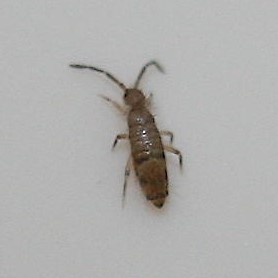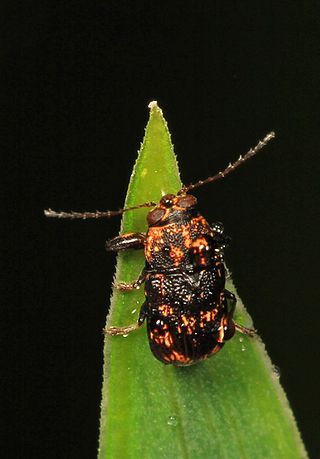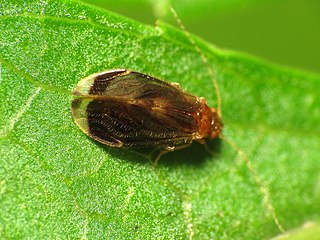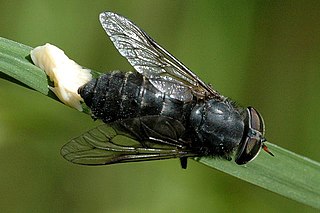
Entomobryidae, sometimes called "slender springtails", is a family of springtails characterised by having an enlarged fourth abdominal segment and a well-developed furcula. Species in this family may be heavily scaled and can be very colourful. The scale-less Entomobryidae are commonly caught in pitfall traps around the planet, and also occur in canopy faunas high up in trees. There are more than 1700 described species in Entomobryidae.

Pallopteridae is a family of flies. The various species are collectively called flutter-wing flies, trembling-wing, or waving-wing flies, because of the striking vibration of the wings in many species. Over 70 species in about 15 genera are found in the temperate regions of the Northern and Southern Hemispheres.

Rhingia campestris is a species of hoverfly, 7–11 millimetres (0.3–0.4 in) long, with a wingspan of 12–18 mm (0.5–0.7 in). It is common across the Palearctic from March until November. It has a broad orange abdomen with a black line along the sides, and has the distinctive long snout of all Rhingia species. Rhingia campestris is the main pollinator for many plant species and due to its long snout it can forage on tubulous flowers. Larvae are associated with cow dung. Adults males feed on nectar, while adult females feed on protein rich pollen, reflecting the cost of developing eggs.

Pachybrachis is a genus of scriptured leaf beetles in the family Chrysomelidae. There are at least 220 described species in Pachybrachis.

Amphipsocidae is a family of hairy-winged barklice in the order Psocodea. Most species are 3.0-4.5 mm long and have many setae (hairs) on the veins and margin of the forewing. The main veins of the forewing are usually lined with two rows of setae. Like the other members of the infra-order Caeciliusetae, they have a broad, flat labrum, with well defined edges.
The Catalogue of Life is an online database that provides an index of known species of animals, plants, fungi, and microorganisms. It was created in 2001 as a partnership between the global Species 2000 and the American Integrated Taxonomic Information System. The Catalogue is used by research scientists, citizen scientists, educators, and policy makers. The Catalogue is also used by the Biodiversity Heritage Library, the Barcode of Life Data System, Encyclopedia of Life, and the Global Biodiversity Information Facility. The Catalogue currently compiles data from 165 peer-reviewed taxonomic databases that are maintained by specialist institutions around the world. As of September 2022, the COL Checklist lists 2,067,951 of the world's 2.2m extant species known to taxonomists on the planet at present time.

The Encyclopedia of Life (EOL) is a free, online encyclopedia intended to document all of the 1.9 million living species known to science. It aggregates content to form "page"s for every known species. Content is compiled from existing trusted databases which are curated by experts and it calls on the assistance of non-experts throughout the world. It includes video, sound, images, graphics, information on characteristics, as well as text. In addition, the Encyclopedia incorporates species-related content from the Biodiversity Heritage Library, which digitizes millions of pages of printed literature from the world's major natural history libraries. The BHL digital content is indexed with the names of organisms using taxonomic indexing software developed by the Global Names project. The EOL project was initially backed by a US$50 million funding commitment, led by the MacArthur Foundation and the Sloan Foundation, who provided US$20 million and US$5 million, respectively. The additional US$25 million came from five cornerstone institutions—the Field Museum, Harvard University, the Marine Biological Laboratory, the Missouri Botanical Garden, and the Smithsonian Institution. The project was initially led by Jim Edwards and the development team by David Patterson. Today, participating institutions and individual donors continue to support EOL through financial contributions.

The long-snout torrent frog is a species of frogs in the family Ranidae.

The thick-billed green pigeon is a species of bird in the family Columbidae.

The long-billed woodcreeper is a sub-oscine passerine bird in subfamily Dendrocolaptinae of the ovenbird family Furnariidae. It is found in Bolivia, Brazil, Colombia, Ecuador, French Guiana, Peru, and Venezuela.

Eristalinae are one of the four subfamilies of the fly family Syrphidae, or hoverflies. A well-known species included in this subfamily is the dronefly, Eristalis tenax.

Rhingia is a genus of hoverflies. They all have a very distinctive long snout. The larvae are associated with animal dung. Adults feed on nectar and pollen.

Hybomitra is a genus of horse flies in the family Tabanidae. There are at least 240 described species in Hybomitra.

Odorrana, commonly known as odorous frogs, is a genus of true frogs (Ranidae) from East Asia and surrounding regions. Many of these frogs inhabit fast-flowing mountain streams, and they typically have a remarkably pointed snout, as evidenced by common names like tip-nosed frog and scientific names like nasica or nasutus.

Campiglossa is a genus of fruit flies in the family Tephritidae. There are at least 190 described species in Campiglossa.

The Taiwanese brown-toothed shrew is a species of shrew in the tribe Nectogalini. It is found only in Taiwan. It prefers dense ground cover in forests and subalpine shrublands in high mountains of central Taiwan. Its placement in Episoriculus has been questioned, with genetic analysis finding that it is more basal within Nectogalini than other members of Episoriculus.

Lachesilla is the main genus in the psocopteran family Lachesillidae. There are at least 310 described species in Lachesilla. Frequent species in the Northern hemisphere include Lachesilla quercus and Lachesilla pedicularia. Some species are localized: Lachesilla merzi has been collected only once in Spain and Lachesilla rossica, apart from the original specimens that were found in southern Russia, is only known from the Valley of the Allondon river, near Geneva, Switzerland.

iNaturalist is an American 501(c)(3) nonprofit social network of naturalists, citizen scientists, and biologists built on the concept of mapping and sharing observations of biodiversity across the globe. iNaturalist may be accessed via its website or from its mobile applications. iNaturalist includes an automated species identification tool, and users further assist each other in identifying organisms from photographs. As of 17 June 2023, iNaturalist users had contributed approximately 161,278,660 observations of plants, animals, fungi, and other organisms worldwide, and around 350,000 users were active in the previous 30 days.
Criorhina nasica is a species of hoverfly in the family Syrphidae.

















